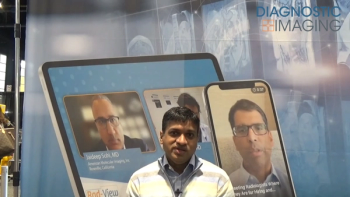
Hitachi begins multislice marketing campaign in U.S.
Hitachi is hoping for a comeback in the world’s premier market for CT. The company, which for many years supplied CT scanners under the Philips Medical System label, has launched its own brand, the quadslice CXR4. It is the first in what will become a family of products with varying capabilities, extending ultimately to the highest levels of performance.
Hitachi is hoping for a comeback in the world's premier market for CT. The company, which for many years supplied CT scanners under the Philips Medical System label, has launched its own brand, the quadslice CXR4. It is the first in what will become a family of products with varying capabilities, extending ultimately to the highest levels of performance.
The first CXR4 is operating at the HealthSouth Diagnostic Center just outside Dallas. Before its arrival in January, the center had performed x-ray, fluoroscopy, ultrasound, and open MR. Staff there have since added routine CT studies of the head, neck, and abdomen and expect to add vascular studies in the coming weeks.
The Dallas center exemplifies Hitachi's target market: small to midsize freestanding imaging centers that don't offer CT or that operate antiquated single-slice systems. The company is especially interested in the 1500 freestanding imaging centers that operate Hitachi's open MR scanners, giving it a marketing foot in the door. About half of these centers do not have CT, according to Sharon Durk, CT marketing manager for Hitachi Medical Systems America. About half of those with CT operate a single-slice scanner.
"For many of them, the time has come to begin offering multislice CT," Durk said.
CXR4 will meet many of their needs, she said. The system is not just a quadslice scanner but one based on the most advanced technology available at its performance level. Buoying performance is an Avia workstation, which offers advanced volumetric reconstruction. The workstation, developed by the Mirada subsidiary of CTI Molecular Imaging, is a featured peripheral of Hitachi's Sceptre P3 PET/CT scanner, which incorporates the CXR4. Sceptre P3 was unveiled at last year's Society of Nuclear Medicine meeting (SCAN 7/16/05)
By midyear 2005 Hitachi Medical Systems of America expects to add a 16-slice scanner to its CT portfolio. Sales training about the scanner will begin in summer. Market rollout is expected in mid- to late fall, with the first installation by year's end.
Eventually, Hitachi's portfolio will include a 64-slice scanner. As other companies have done, Hitachi plans to shift its marketing focus with advancing technological capability. Quadslice, however, is a good place to start, Durk said.
The step to center stage after a five-year hiatus from the North American marketplace is a natural progression for Hitachi, which has maintained its presence in other CT markets around the world but not played in the U.S. since losing its supply agreement with Philips. Hitachi was pushed out of this marketplace when Philips bought Marconi Medical, which had a range of low-, mid-, and high-tier CT models. Hitachi remained active in other world markets, however, winning a sprawling base of installed systems.
"Hitachi has manufactured and installed close to 9000 CTs worldwide over the last 30 years," Durk said. "That's a heck of a lot of technology behind us."
Newsletter
Stay at the forefront of radiology with the Diagnostic Imaging newsletter, delivering the latest news, clinical insights, and imaging advancements for today’s radiologists.




























